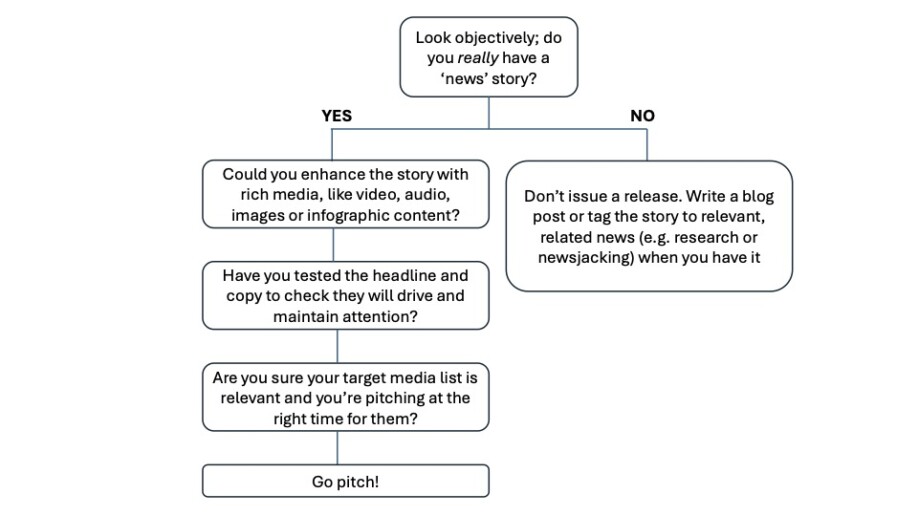Love them or loath them, the press release seems set to stay as a PR tool. Very few of them are effective, so – having written hundreds and received tens of thousands of press releases in my career – here’s your guide on how to write an effective press release.
The jury is out on the value and future of the press release, but the fact of the matter is that for most organisations it is still the favoured mechanism by which comms professionals distribute stories to media and bloggers.
However, as a freelance digital consultant who’s worked in both tech journalism and PR, as well as being a football culture blogger, I have not only drafted hundreds of press releases but have been on the receiving end of tens of thousands. Many of these were deleted without being read.
It’s sad but true – having seen the effort and often protracted revision and approval processes – that most releases will fail to generate the media interest that clients and agencies alike would hope for.
Why press releases fail, and how to change that
There are many reasons why press releases fail to get traction with the media or bloggers, which could be one, or a combination, of the below:
1) There was no story
Anecdotally, this is probably one of the main reasons press releases fail. Many releases are written for vanity reasons and lose sight of the target audience of the media they aim to send the release to.
The most important question to ask is why would anyone care? If you can’t answer that, then you don’t have a story. Write a blog post instead if you’re itching to say something.
2) The headline didn’t grab attention
As a tech journalist in the newsroom I used to receive upwards of 200 press releases each day. I recently asked a few contacts of mine and they likewise tended to receive 50-200 each day. For nationals, expect that to be a lot higher. Of course, many of these will come from wires, reducing the personal approach and probably duplicating in the inbox, as the recipient may well have been pitched to personally.
No journalist ever has appreciated a phone call from a PR asking; “did you get the press release?” And they have been telling PRs this for as long as I’ve been in this industry (nearly 18 years) and yet it still happens!
If in doubt, make sure your team receives some influencer relations training.
3) The release was badly written
One of my favourite football crowd banners was this below that I spotted at a Fortuna Düsseldorf match in Germany a couple of years ago. It reads “Copy and paste is not journalism”. While I don’t know what incident that particular banner was specifically referring to, it does raise an interesting point. In an era when journalists are under extreme pressure to turn around stories quickly for a hungry online audience, there is a temptation to lift copy.
Yet many stories – especially B2B – are written in dry, corporate speak, often with many niche acronyms and assumed knowledge. This turns journalists off as they have to effectively translate the article for their audiences.
Instead, try writing as close to media style as possible. This will require a cultural change in some organisations but have a look at the tips below on how to write a great press release
4) There was no rich media to support the release
Building on the ‘make it easy for the journalist’ theme, web publishers want rich content. That could be embeddable video, audio, images or infographics. How can you bring your story to life? Provide links to the content so the journalist can download and use in their own time.
5) You sent the release as an attachment
Seriously, this still happens…
6) Your timing was out
Do you know when your target publication has its team meetings?
7) What you offered wasn’t unique
This applies to bloggers more than media. You cannot spam bloggers with press releases. They want unique experiences and content to share with their hard-earned audiences.
8) A bigger story came along
This happens and is out of your control. If circumstances intervene, think about a new angle.
Hacks on how to write a great press release
There is no set formula or template for press releases, but the one I typically follow is:
Email subject
Generate a clickbaity title that entices the click. Add some mystery and use hyperbole within reason.
DO NOT USE CAPITALS. IT LOOKS LIKE SHOUTING!
Also avoid using the words “Press Release” to start you subject title. It uses up valuable space and is kind of self-evident.
Test-run a few potential subject titles through the Coschedule Headline Analyzer tool and aim for as attention-grabbing a title as possible.
Top-line pitch
Before you launch into the meat of the release, write a personalised pitch to that journalist with some easy-to-scan key points. For example;
Hi Sandra
I saw your recent piece on X [link]. I can take this story further, did you know that Y? That is important to your audience because Z.
In brief:
– Fact
– Stat
– Quote/citation
Please see below release and I have [spokesperson] available and images [link to Flickr, Dropbox, WeTransfer or similar] for you to use.
Many thanks
[Name]
[Contact details]
Press release title
Get to the point. Kill your darlings, less is more. Use Coschedule Headline Analyzer again
Consider a subhead to get any secondary points in early.
Press release body
(Again) GET TO THE POINT. First para must both summarise and entice the reader to continue.
I write my copy in Word then run it through Grammarly to ensure I use short, easy-to-read sentences, check for adverbs and use of the passive voice.
Ditch corporate speak and write as close to the style of target publications as possible. If your words get copied and pasted by the media, great!
All quotes should focus on what the release means to publications’ target audiences NOT your company. No one cares about your company. Sorry to break it to you.
I used to write for IT managers, so I spent time talking to them, understanding what kept them awake at night – security, uptime, return on investment etc. – and vendors should address the issues that matter to the audience, not flatter internal egos or aim to tick coverage boxes.
Rich content
Support your copy with rich content to bring it to life.
Are you trying to explain something complex? Would a video or podcast file help describe it?
Have you carried out research? Would an infographic or flowchart help articulate your findings?
Could your story be supported by impactful images? If so, provide hi-res images via a download link, such as Flickr, Dropbox, WeTransfer or similar.
Press release flowchart
Make sure you follow the below flowchart when considering creating press releases.
[Updated for 2024] I would guard against using generative AI for creating press releases, even closed networks. You should focus on creating content with the brand voice in mind. Always.
If you need an expert press release writer then please get in touch.


